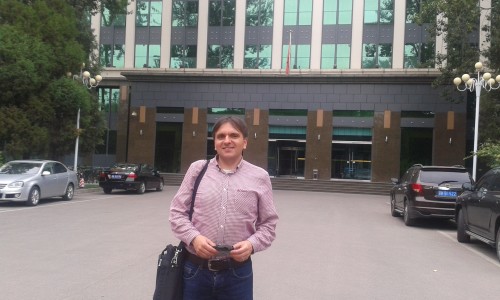
Matin Durrani outside the Institute of High Energy Physics in Beijing before interviewing Xinchou Lou.
By Matin Durrani in Beijing, China
I had just landed in Beijing this morning when I saw an e-mail from my colleague Mingfang Lu waiting for me on my phone. Mingfang, who’s editor-in-chief at the Beijing office of the Institute of Physics, which publishes Physics World, has been helping me to organize my itinerary for the next week as I gather material for our upcoming special report on physics in China. You may remember we published a Physics World special report on China in 2011 but so much has happened since then that we felt it’s easily time for another.
Mingfang’s e-mail was to say we would be off at 2.30 p.m. to interview Xinchou Lou, a particle physicist at the Institute of High Energy Physics, about the country’s ambitious plans for a “Higgs factory”. If built, this 240 GeV Circular Electron–Positron Collider (CEPC) would be a huge facility (50 km or possibly even 100 km in circumference) that will let physicists study the properties of the Higgs boson in detail. I say “if”, but knowing China’s frenetic progress in physics, it will almost certainly be a case of “when”.
Now if you’re wondering why my interview with Lou was held on a Sunday, it was because China held a public holiday last Thursday to mark the country’s Dragon Boat Festival. To make up for lost time, today has been a full working day. That hard-working and enterprising mentality has served China well in recent years, not least in science, with the country now publishing more papers in physics than any other nation.
Lou himself is testimony to China’s burgeoning scientific strength. He left China in 1984 for the West and – after spells in California, New York and CERN – settled at the University of Texas, where he remained for almost two decades before returning home in 2012. He was tempted back by the country’s “Thousand Talents” programme, which seeks to deepen the country’s scientific base by encouraging overseas scientists (both Chinese and non-Chinese) to move here.
Crucially, Thousand Talents staff are allowed to apply for grants – something foreigners aren’t otherwise permitted to do – though Lou says, half jokingly, that what really attracted him to IHEP was that the building is air-conditioned.
“China’s a different country from when I first left,” says Lou, who reveals he struggled to learn how to type Chinese characters into a computer – a skill that didn’t even exist when he left in the 1980s.
Now, though, it’s full steam ahead with plans for the CEPC. Potential sites in China to host the facility are being investigated (the current front-runner is located, rather handily, near a holiday beach). Staff are being recruited to IHEP and a research team is being assembled. Money is also being sought to build a prototype collider, which would cost about one billion yuan (about $150m).
With a fair wind, construction will start in 2021–22, with data rolling in by about 2028. And if all goes to plan, the collider could even be upgraded, using the same infrastructure, to form a proton–proton collider with a centre-of-mass energy of up to 100 TeV. Such a collider would totally outperform CERN’s Large Hadron Collider, which operates at just 14 TeV.
“Building a proton–proton successor to the CEPC would totally transform physics in China,” Lou says. “It wouldn’t be a quantum leap but a multiple quantum leap.”
Well, Matin let us hope that you would glean maximum of information in an environment of exponential activity and creativity of China: if they plan the 240GeV CEPC, they may construct it very quickly like a skyscraper that is built in a couple of weeks!